|

Lasíthi
Plateau
The Lasíthi
Plateau, located in the Prefecture
of Lasithi in Eastern
Crete, is one of the highpoints of Crete, both in
altitude and atmosphere, for it is unique: a green carpet
hemmed in on all sides by the Díktean
Mountains, snowcapped into April and irrigated in summer by windmills. The
picturesque windmills work regularly to water the fertile
plain which covers an area of approximately 25,000 sq. km.
As the excavations carried out on various sites have shown,
this inaccessible area, encircled by high mountains ranges
has been inhabited since Neolithic times. The plateau was farmed by the Minoans and later by the Dorians of Lyttos,
but in 1293 it was such a nest of resistance that the
Venetians forced everyone out, demolished the villages, set
up guard around the passes and persecuted anyone who drew
near. Only in 1543 were Greek refugees from the Turkish-occupied
Peloponnese permitted to
resettle the plateau. To reestablish the orchards, the
Venetians built 10,000 white-sailed irrigation windmills. Although very few windmills are in use today, it still makes a splendid sight
against the mountains. The uncanny
cave where Zeus was born in Psychró, 63 ½ kms. from Herakleion,
is the chief attraction.
Click on the thumbnails below in order to see pictures of the Lasíthi Plateau.
Use your browser's back button
to return to this page.



|
|
|
|
|
 Bird's
eye view
of the northern Crete coastline on the way to the Lasíthi Plateau. Bird's
eye view
of the northern Crete coastline on the way to the Lasíthi Plateau.
|
|
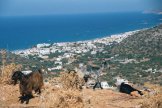 Goats
along the northern coastline of Crete. That feta cheese we ate on all
those Greek salads had to come from somewhere... Goats
along the northern coastline of Crete. That feta cheese we ate on all
those Greek salads had to come from somewhere...
|
|
 A
row of stone windmills at the Séli Ampélou Pass marks the
northern entry to the
plateau, a flat agricultural area lying 800 m (2,600 ft) above sea level
and encircled by mountains. A
row of stone windmills at the Séli Ampélou Pass marks the
northern entry to the
plateau, a flat agricultural area lying 800 m (2,600 ft) above sea level
and encircled by mountains. |
|
|
|
|
|
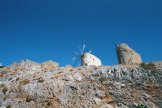 The
windmills belong to individuals and some of them have been restored while others
still remain half-ruined. The
windmills belong to individuals and some of them have been restored while others
still remain half-ruined. |
|
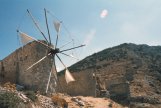 The
stone windmills are still used for grinding wheat. Today 24 out of the original
26 windmills are preserved. The
stone windmills are still used for grinding wheat. Today 24 out of the original
26 windmills are preserved. |
|
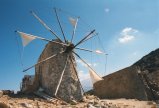 Detail
of one the stone windmills at the pass. Detail
of one the stone windmills at the pass. |
|
|
|
|
|
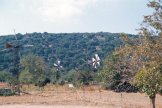 Modern
mechanical windmills pump water for fields of potato and apple and almond
orchards. Modern
mechanical windmills pump water for fields of potato and apple and almond
orchards. |
|
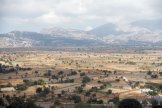 The
Lasíthi Plateau
- a fertile checkerboard divided by drainage ditches and dotted with
windmills in a bowl of barren mountains. This picture was taken from
outside the entrance to the Cave of Psychró located at an altitude of 1025
meters above sea level on the northern slopes of Mountain Dikti. The
Lasíthi Plateau
- a fertile checkerboard divided by drainage ditches and dotted with
windmills in a bowl of barren mountains. This picture was taken from
outside the entrance to the Cave of Psychró located at an altitude of 1025
meters above sea level on the northern slopes of Mountain Dikti. |
|
 The
entrance to the Cave
of Psychró (Diktaean
Cave) is through an enormous opening which lights
up the deepest recesses of the cave. The cave consists of a large chamber
divided in its lower part into four smaller areas, all adorned with stalactites
and stalagmites. The
entrance to the Cave
of Psychró (Diktaean
Cave) is through an enormous opening which lights
up the deepest recesses of the cave. The cave consists of a large chamber
divided in its lower part into four smaller areas, all adorned with stalactites
and stalagmites. |
|
|
|
|
|
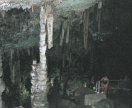 Only
rediscovered in the 1880s, the cave contained cult items from the Middle Minoan I period (around 1800
BCE), if
not before, through the Geometric and
Archaic periods. It was also visited later on in Roman times. A wealth of artifacts have been unearthed here
including votive offerings, double axes, and bronze statuettes, now in the
Herakleion Archeological Museum. Only
rediscovered in the 1880s, the cave contained cult items from the Middle Minoan I period (around 1800
BCE), if
not before, through the Geometric and
Archaic periods. It was also visited later on in Roman times. A wealth of artifacts have been unearthed here
including votive offerings, double axes, and bronze statuettes, now in the
Herakleion Archeological Museum. |
|
 A strong tradition has it that Minos came up here to receive the law of
Zeus every nine years and that Epimenides, the most renowned seer, wonderworker and poet of ancient
Greece, who was
also connected with the cult of Orphism, "slept" in this cave for many years and
had various divine visions. Epimenides is considered to have been a historical
person.
A strong tradition has it that Minos came up here to receive the law of
Zeus every nine years and that Epimenides, the most renowned seer, wonderworker and poet of ancient
Greece, who was
also connected with the cult of Orphism, "slept" in this cave for many years and
had various divine visions. Epimenides is considered to have been a historical
person. |
|
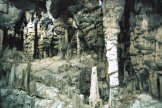 The
cave's role as the birthplace of Zeus was confirmed by the discovery in
Palékastro of
the Hymn of the Kouretes (the young men who banged their shields to drown
out the baby's cries from his cannibalistic father, Kronos). The
cave's role as the birthplace of Zeus was confirmed by the discovery in
Palékastro of
the Hymn of the Kouretes (the young men who banged their shields to drown
out the baby's cries from his cannibalistic father, Kronos). |
|
|
|
|
|
 The
ascent to the Diktaean cave is via this one-kilometer rocky, stepped path.
Sure footed donkeys are available so, of course, I had to take a picture
with one before we left. J The
ascent to the Diktaean cave is via this one-kilometer rocky, stepped path.
Sure footed donkeys are available so, of course, I had to take a picture
with one before we left. J |
|
|
|
|
|
|
|
|
|
© All pictures are Copyright 2000 Grisel Gonzalez and Jeff
Prosise
|